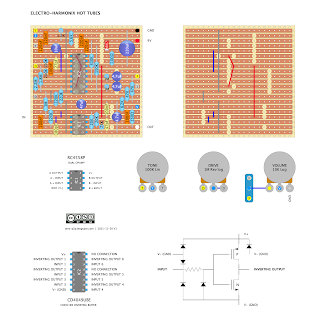THE PROBLEM WITH VERO / STRIPBOARD LAYOUTS
As much as I like a bit of vero (clearly), vero is not meant for commercial-scale production, at least in the modern sense. Unlike PCBs, where pots and switches can all be mounted on the board, thus providing a convenient way to hold the board in the enclosure, vero layouts are almost never designed this way. This brings us to the issue at hand - I've built it, now how do I make it stay put in the box, or how do I know this thing will be reliable?
Vero, or stripboard layouts are often laid out by folks like me, with small size often being the main driver of the layout, without any consideration for anything else. What is rarely seen on layouts is space for mounting points, or any indication of how it should be laid out in an enclosure with pots, jacks, switches etc. Sure, we all like to do our own thing, but it's kind of hard to work out when you're just starting out. I know when I was starting out, boards were jammed in enclosures in any way possible, usually with a lot of excess wire. As long as it worked and I could close the lid, I was happy.
SO WHAT TO DO?
Well, kind of obvious - secure the vero board to the enclosure properly. The board is literally full of things that you don’t want touching the enclosure, switches or any other conductors.
HOW TO MOUNT VERO IN A GUITAR PEDAL ENCLOSURE?
Standoffs
This is my preferred method. Self-adhesive plastic standoffs are pretty handy - but you will need to check if there's space on the layout for a few holes and that there is enough room in the enclosure once the pots and switches are in (which should happen first, in my opinion). If there isn't enough room, see if there's room to add a couple of rows or columns to the vero layout for mounting holes.
Standoffs come in many different shapes and sizes, usually with a plastic snap to lock them in place, or a small screw. Naturally, if you are using the metal screw type, make sure that the screw isn't shorting the conductive strips on the vero board. Of course, there is the bulletproof method, of screwing the standoff all the way through the enclosure, but this is a little harder to do and can limit space for graphics on the front.
This is a small point-to-point board - a single screw was enough to secure it. In retrospect, I should have used two.
Plastic standoffs on each end of a D*A*M Fuzzsound worked well
Glue
Quite a few people use hot glue guns to secure boards, and it works, but good luck if it ever needs repair.
Tape & Velcro
Thick double-sided tape and velcro also does the job. At least with Velcro, you can remove it for repair, but something about velcro in a pedal bothers me.
Gum
No not that type of gum. This is a suggestion from a comment left on the post (thanks Brain). There's a sticky gum/gel specifically designed for sticking down boards, but you can still remove them later (with a bit of effort).
https://guitarpcb.com/product/gum-wadz-pcb-mount/
LAYOUT PLANNING
I normally look at the vero layout, pots, switches and enclosure size before starting the build. This way I can get a feeling for how I might finish, before I start. Kind of frustrating to have something in mind, only to find that it was never going to fit after building the circuit. I learnt this the hard way, maybe more times than I care to admit.
After I've built and tested the circuit (with ample wiring already on the board), I double-check that everything fits, by first adding the jacks, switches and pots to the finished enclosure. Then drop the board in, to confirm the initial plans are still valid.
I usually wire up the jacks, stomp switch and LED first - then I attach the circuit to the enclosure, and cut the cable to size, and solder connections as required.
Another method I sometimes use is to create a cardboard wiring jig, and do most of the work there, before transferring to the proper enclosure. This just provides a bit more room to move, as some enclosures can be a little cramped to work in, and it works out about the same in terms of final product.
How bad does the cardboard jig look? This is the Revox A77 preamp that I put in a wedge enclosure.
WHAT TO AVOID WHEN MOUNTING CIRCUITS IN PEDAL ENCLOSURES?
Now I think I've done nearly all of these things at one stage - so no judgement if you have too.
Try not to:
- Wrap it in electrical tape, sure it works, but what a mess
- Stick it in a plastic component bag
- Do nothing and hope for the best / won't the wires just hold it where it should be?

















































